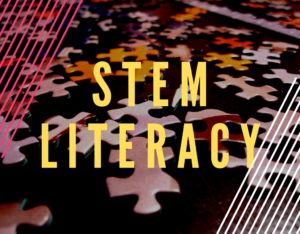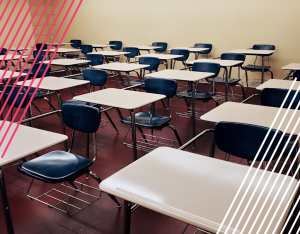Are you trying to figure out what a STEM lab is or how to start one? If so, you’ve come to the right place. In my years visiting schools, I have seen several different STEM labs, so I’m here to talk about them.
As the popularity of STEM increases, the number and variety of STEM lessons and activities increase with it. STEM labs are an essential aspect of allowing them to be done or to enhance them. But without proper planning, a STEM lab can become a total failure.
Table of Contents
What Is a STEM Lab?
A STEM Lab is a wholly integrated learning environment for learning where everything from the technology and furniture to curriculum and assessment support each other to provide hands-on learning. It’s where learning can be personalized and motivating to engage all types of students. A STEM Lab allows students to learn, explore, collaborate and create, and problem-solve.
STEM lab programs are designed to accommodate each grade. Program elements, including construction kits, classroom design, technology, curriculum, and scope and sequence, work together to advance students from where they are currently.
In the STEM lab, students acquire the learning skills of the 21st century by participating in projects that cultivate critical thinking, problem-solving, collaboration, communication, intellectual curiosity, and flexibility.
The project-based learning environment allows students to develop STEM skills by applying technology to design their own projects.
Why Build a STEM Lab?
Within the past decade, schools have increasingly been trying to find ways to encourage students to develop a passion for science, technology, engineering, and math. Many have been successful by introducing them earlier and engaging them with attractive, new learning spaces that feature the latest technology, such as robots and virtual reality.
Some schools have even started using technology in pre-kindergarten, weaving it into every subject through to the 8th grade. Computer science curriculums start in preschool with wooden robots that allow students to learn coding fundamentals and gain confidence with technology at a young age.
Schools with the budget have divided STEM labs that include a computer lab to learn coding and robotics and a virtual reality lab to explore the solar system and study human anatomy.
Studies have shown that students become more interested in STEM education when they are introduced to it earlier. STEM labs naturally gain interest from many younger students because of their curious nature and desire to create and build.
Part of the U.S. STEM initiative is to get more women into STEM fields. Starting STEM at an early age can break the stereotypes of boys being naturally better at engineering and allow girls to excel in it just as much.
School districts invest in STEM education to provide students with the essential skills they need to flourish in their future careers. This ranges from technical expertise to creativity, problem-solving, communication, critical thinking, collaboration, and communication.
Many schools are building STEM labs to start or strengthen their STEM programs. For example, advanced manufacturing labs allow students to experience hands-on learning with the ability to design and build their own products by using microcontrollers and circuit boards, 3D printers, and laser cutters.
Dedicated spaces used for access to technology and where students feel confident in tackling high-level problems is crucial for the development of 21st century STEM skills.
STEM labs offer collaborative working spaces
Collaboration is a vital STEM concept that helps students learn how to lead or be more effective in groups. Working in diverse groups also exercises the skill of flexibility by adapting to different beliefs and ideas to reach a solution.
Creating student-centered learning environments is an integral part of a STEM lab. If huge Silicon Valley corporations like Google can move away from the traditional cubicle office setup and be successful in having innovation hangout spaces where great ideas are cultivated, then the same concept can be applied to school STEM labs.
STEM labs provide practical experiences
The design thinking concept involves understanding the problem, creating a solution, and testing it until it’s the best it could be. Schools are teaching this concept through STEM education. But, although the main goal is to pique student interest in pursuing a STEM career because of the shortage of skilled workers in its fields, the skills students learn from STEM can be applied to everything they do.
STEM is an authentic way of learning because in essence, it’s about critical thinking and learning from struggles and failures to work through the problems.
STEM labs help attract underrepresented groups
Another big part of the STEM initiative is to inspire particularly underrepresented groups such as girls and people of color to explore STEM. STEM labs are welcoming environments for every student who wants to participate.
Some schools don’t even require filling out an application to join programs. This makes it more welcoming for anyone with interest rather than just the best and the brightest.
Optimal learning environments produce smoother learning curves
To better allow for classroom innovation, Charlottesville High School’s 7,200 square-foot Sigma Lab brought in a practical, and also powerful tech infrastructure. This STEM lab includes a computer lab and an advanced fabrication lab that houses network-connected CNC machines, laser cutters, and 3D printers, where students can design and build products like robots or prosthetic hands. Its informal collaboration space is made up of glass-walled project rooms with soft armchairs, tables, interactive displays, and whiteboards so that students can work on projects together.
To provide Charlottesville’s third through twelfth graders access to digital media and design programs like computer-aided design (CAD) or Adobe Creative Cloud, the district put in powerful desktops in their middle and high school tech labs. The walls of the space allow teachers to show video clips or coding examples through 12 large, interconnected LED displays.
To support its high-tech STEM lab, the Charlottesville district built its own virtual dedicated one gigabit-per-second Local Area Network (LAN). This LAN ensured the computers and video walls had enough bandwidth to protect video traffic, making sure they produced its highest quality.
The district’s IT department also installed wireless access points, so students could use their Chromebooks in project rooms to work and collaborate.
STEM labs use flexibility to create more opportunities for hands-on experiences
Many schools have designed their STEM labs with flexibility in mind to expand its potential. Chromebooks or Microsoft Surface Devices are commonly issued to students to do classwork. High-powered desktops with large touch-screen monitors are available in STEM labs for video editing and other spec-heavy software.
High-powered computers are not only used for video and music production, but they are also used for coding and programming robots. Tables are set on wheels so they can be set to work on robots or be pushed away to give students more room on the floor for robot obstacle courses.
STEM labs provide equipment for all learning levels
STEM labs aren’t just for intermediate or advanced students. Plastic or wooden robots that are programmed by adding specific blocks for commands are used by children to learn coding concepts. As students progress, they can work on more sophisticated robots that are programmed through computers using block-based programming or more simple text-based programming languages such as Python.
STEM labs use technology to teach and create in different ways
Many STEM labs have included virtual reality equipment to allow students in third grade and up to experience learning and creating in easier, or in some ways, more effective ways. Students wear headsets and use controllers to explore human anatomy or take virtual field trips to museums. They can also design objects to be printed on 3D printers.
STEM labs support pedagogy
In September 2017, the Bullis School in Potomac, Md. opened its treasured STEM building called the Discovery Center. The $25 million, 70,000-square-foot state-of-the-art building almost doubled the classroom space for its independent K-12 school. It includes a digital media studio, a fabrication lab, a makerspace, and over 20 classrooms and science labs.
According to Faith Darling, the Bullis School’s STEM director, the Discovery Center has allowed the school’s STEM course offerings to be expanded and to offer more sophisticated learning experiences.
Its rooms use control panels to control projectors and lights. 3D virtual reality computers are available in one of the computer labs. A digital media classroom holds powerful laptops with Adobe Creative Suite for video editing, along with a sound studio and a green screen. 3D printers and robotics are located in the makerspace. Its classrooms are set up to encourage collaboration and project-based learning. Video screens are at the end of each table to allow students to connect to them and display their work.
Math isn’t usually associated with project-based learning, but Jamie Dickie, Bullis School’s technology director, says that they want that to be their approach.
The Discovery Center’s design required input from school leaders on how teachers might use available technologies. Darling says that technology shouldn’t be purchased for technology’s sake; but rather to support the program.
It was getting input from those in the trenches before building is what makes the Discovery Center so great. Technology mustn’t be mainly used in STEM labs to show off and make it look more attractive. It should be used to support the pedagogy.
STEM labs embrace “geeks.”
Within the past decade, there have been several blockbuster movies that have come out about tech entrepreneurs. Films like The Social Network or Steve Jobs have made tech “nerds” look cool with their superior intelligence and creativity. Even some of the most popular YouTube channels are ones that focus on science and technology. The old negative view on “nerds” seen in pop-culture has begun to reverse, making geeks rise up the social ladder and grow. Schools have long had sports teams and training facilities for athletes, so since geek culture has been gaining popularity, we must have spaces to accommodate them as well. Along with the nation’s need for more STEM skilled workers, there is no better time to start a STEM lab than now.
How To Build a STEM Lab
Before we get started, I would like to mention that I am not a school teacher or administrator. But, I am a youth services librarian with years of visiting all of the schools in the district to do outreach multiple times during the school year under my belt. I am lucky for the fact that all of the teachers love to talk all about their beloved STEM labs with pride. Along with my extensive research on STEM activities for each grade, I am confident in explaining the best way to implement a STEM lab in your learning facility.
Create a “STEM Lab” Sign
Inspiration can lead to enhanced creativity and innovation. One of the most important things about a STEM lab is that it should inspire. An easy way to inspire is to put up a “STEM Lab” sign that stands out. The sign will not only let everyone know what the space is, but it will also remind students that they are a part of something new. Their parents didn’t have a STEM lab when they were in school, so students should acknowledge that the STEM lab is for their generation, and that’s what makes it cool.
An excellent way to 2x this is by having students make the sign. If you’re engineering inclined, you can create a flashy DIY STEM Lab sign using an Arduino and LED lights and have students help you as part of a lesson. If you’re not comfortable with you or your students handling electronics, you can find ways to make it into a craft project by using items you may already have in your classroom. If you have an art teacher on staff, they would be more likely to help.
Go over the lessons
As mentioned earlier, technology should not be included in STEM labs for the sake of technology. The priority is the pedagogy, and technology is simply the means to support it. It is unfortunate, but I have seen schools that have purchased expensive technology for their STEM lab just to receive more grant money. The technology ends up never or hardly being used because there was never a need for it, or no one had the knowledge to use it. It may seem obvious, but the point is that the second step of creating a STEM lab should be to explore what is needed to teach the STEM lessons or to enhance them.
Many STEM lessons and activities are designed to use items already on hand to show how STEM skills can be used in the real world. Things like rubber bands, magnifying glasses, and storage boxes may be found in supply closets or can be purchased after the STEM lab has opened. But, there are things that need to be planned out to make lessons easier. Many STEM activities require water, so putting the STEM lab near a bathroom or having one installed in the STEM lab would be a good idea.
Some STEM lessons, like ones that include seed germination, require sunlight. Consider building your STEM lab in a room that has windows facing the sun.
Allow flexibility
STEM activities usually include a teaching or demonstration part and a collaborative part. To allow natural flexibility for teaching formations and collaborative work formations, consider furniture on wheels. This will also allow furniture to be moved out of the way to make more floor space if needed for demonstrating or testing designs.
Some schools have a single STEM lab for all grades, while others have a STEM lab in the classroom for younger grades because it may be harder to move those students around the building. If your STEM lab is for a range of grades, consider using tables and chairs with adjustable height.




